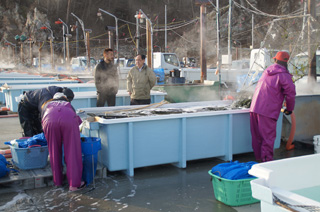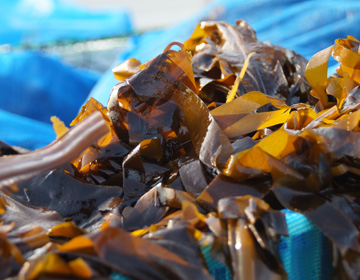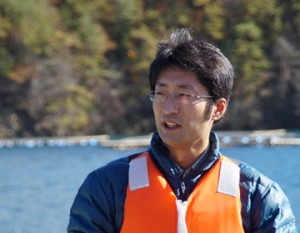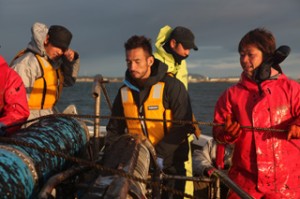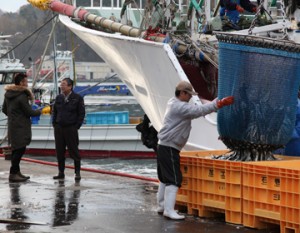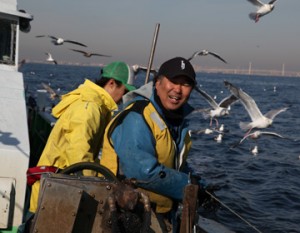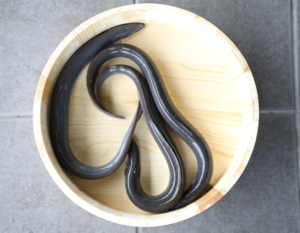Out to sea with the sunrise
Of course fishing starts early in the morning. We accompanied the harvesting of cultivated ”wakame”.
”Wakame does not like sun. To keep the quality, we have to harvest between 1 am to sunrise.” said Atsuo Kitada who works at Omoe Fisheries Cooperative Association. In addition to that, they harvest during this time because the ocean is relatively calm.
Nakata joined the men in harvesting cultivated ”wakame” as soon as the sun was up. It is of course dark all around. But the day had already began for ”wakame” fishermen.
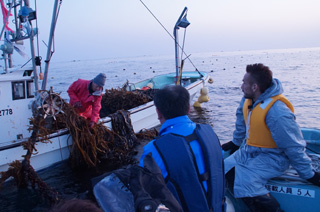
Challenging the ”wakame” harvest
Iwate prefecture is famous for cultivating ”wakame”, Currently, the total production of ”wakame” in Japan is about 60,000 tons. Within the Sanriku area, Iwate prefecture produces 25,000 tons, Miyagi prefecture produces 15,000 tons, a total of 40,000 tons, making Iwate prefecture the number one in ”wakame” production in Japan. Of that, Omoe produces 3000 tons. Every year during June to August, they put the natural seedling of ”mekabu” seaweed on a jute rope and let it grow in the sea. In November they wrap the jute rope around a thicker rope. In January and February the water from melted snow goes into the sea, and the ”wakame” grows quickly. In general, they harvest in March. ”Wakame” is an annual plant so they harvest everything by the middle of April.
Omoe peninsula is at the most eastern spot of Honshu. The characteristic of the ”wakame” from this region is the thickness. Omoe is facing the outer ocean so the tide is very fast, and the ”wakame” is massaged by the tide making it exceptionally thick. They sell it under the ”thick wakame” branding.
The tool they use for harvesting are sickles. As the word suggests, they literary harvest the seaweed from the cultivating ground. Nakata was handed a sickle to help with the harvest. This in fact is a quite hard labor. Of course when we went to interview in spring the wakame was fully grown.
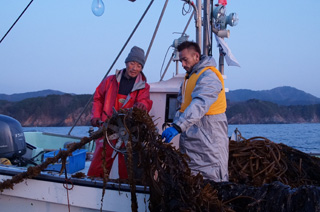
”Wakame” in the warm tide. ”Kombu” in the cold tide.
When the boatful of harvested ”wakame” is brought to shore, the first thing that they need to do is to boil it in sea water. And then they are pickled in salt for preservation. The day only ends after going through these processes. When the season for ”wakame” ends, the ”kombu” season starts, providing work throughout the year.
”Wakame” is a seaweed that grows in warm tidal water while ”kombu” grows in cold tidal water. Kitada told us that the characteristic of the sea of Omoe is that both can grow well.
Furthermore, Omoe Fisheries Cooperative produces a brand of ”wakame” called ”First Spring”. This is young ”wakame” harvested early in the season between January to February. It is high in nutrition and tender, so it is delicious in ”raw wakame shabu shabu”.
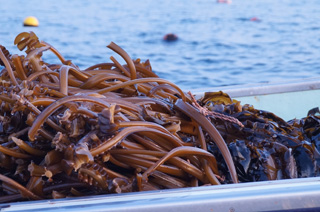
Everyone in the family participates in ”wakame” cultivation
Omoe peninsula was hit hard by the Great East Japan Earthquake. They showed us the scars of the tsunami that remains on the rocks on the beach. However, in the midst of the huge damage, during the early days following the earthquake, people chipped in and purchased and repaired a boat. By the end of May, they were able to harvest wild ”wakame”. Furthermore, they fixed the cultivating facility and processing factory, and 129 of the 181 people who worked there have returned to their jobs.
For most families who cultivate ”wakame”, the whole family is involved in the business. As described earlier, it is hard labor for the elderly, but the young people have also joined in. Junichi Nakamura who worked with us harvesting ”wakame” told us, ”Many young people are returning home from the cities.”
Nakata asked, ”What is the reason that growing ”wakame” is so popular and why are there many young people here?” Kitada replied ”We have jobs here, and we have an environment for them to work.”
The wealth of the ocean and the power of people. They support the ”wakame” of Iwate.
